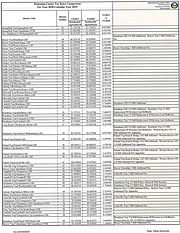Auditor’s chart shows levies led to tax increases

By JUSTIN DENNIS
jdennis@vindy.com
YOUNGSTOWN
Mahoning County Auditor Ralph Meacham said a 2017-2018 tax rate comparison chart succinctly answers questions residents have about their rising property tax bills.
Basically, if you voted for new or increased levies, you’ll pay more taxes, he said in explaining the chart released Wednesday by his office.
Mahoning Auditor Tax Rate Comparison
Mahoning County Auditor Ralph Meacham has created a chart comparing the county tax rate for 2018 and 2019.
Meacham said some residents may think the 2017 revaluation of the county’s about 165,000 parcels resulted in higher property values and thus higher taxes, but that’s not what led to much-higher tax bills in the taxing districts with the largest millage rate increases.
Voted millage rates changed in 20 of the county’s taxing districts, according to the chart.
“The point here is your property taxes went up not so much because of the reassessment but because of the additional levies the taxpayers voted for,” Meacham said.
Taxing districts in which residents voted for the Boardman Local School District’s 5.8-mill, 10-year emergency operating levy in May 2018 saw the largest increases for residential and agricultural properties across the county.
Boardman Township and school district residents are paying for a double-whammy, as residents also approved a 2.9-mill replacement levy in the same election. Before being refreshed, the 1976-approved levy’s effective millage rate wore down to about 1.2 mills. Its replacement better ties it to current property values.
But the largest property tax increase from 2017 to 2018 happened in the taxing district including Boardman Township, Poland Village and Boardman schools, which saw the millage rate increase by about 8.95 based on those two levies as well as a 1-mill additional levy to fund fire equipment for the Western Reserve Joint Fire District.
For context, the owner of a home valued at $100,000 in that taxing district paid about $2,951 in 2017, before any applicable tax credits. In 2018, that tax bill jumped to about $3,264.
There are other special assessments for county taxpayers, Meacham said. The newest comes from the ABC Water and Storm Water District, which began in January building a stormwater infrastructure fund through additional tax charges calculated by properties’ “non-pervious” surface area — meaning surfaces unable to absorb stormwater.
Meacham said the 2017 revaluation raised assessed property values by a little more than 2 percent across the county, from about a quarter-percent to 9 percent between the four property categories: commercial, 0.27 percent; residential, 1.9 percent; industrial, 3.4 percent; and agricultural, 9.1 percent.
A mass appraisal conducted by the auditor’s office every three years considers construction permits, properties’ conditions and final sale amounts for similar properties that have sold in the area.
“We’re trying to estimate a fair market value,” Meacham said.
The tax rate comparison chart for residential and agricultural properties can also be found in the Financial Documents section of the auditor’s website, MahoningCountyOH.gov, as well as embedded in this article on Vindy.com.
 43
43

